Canedy Reveals Changes at Simon & Schuster
Support Journal-isms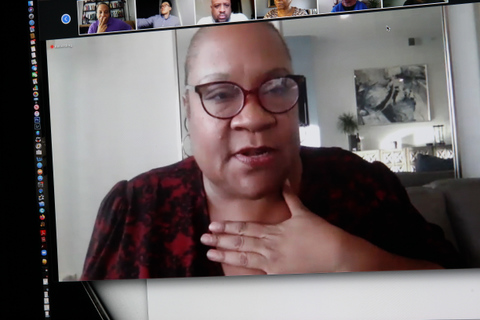
Canedy Reveals Changes at Simon & Schuster
Will 2021 be the year you write that book?
The final Journal-isms Roundtable of 2020 explored how journalists who are so inclined can navigate the book publishing business. It took place Dec. 13, two days after The New York Times published “Just How White Is the Book Industry?,” in which the article’s authors said they “were shocked by the extent of the inequality once we analyzed the data.
“Of the 7,124 books for which we identified the author’s race, 95 percent were written by white people,” Richard Jean So and Gus Wezerek wrote.
“This broad imbalance is likely linked to the people who work in publishing. The heads of the ‘big five’ publishing houses (soon, perhaps, to become the ‘big four’) are white. So are 85 percent of the people who acquire and edit books, according to a 2019 survey.”
But first, the news: Dana Canedy, executive vice president and publisher of Simon & Schuster, who in July became the first Black person to hold the position, updated attendees on her progress in opening up the publishing ranks to more writers of color. Simon & Schuster is the nation’s third-largest book publisher.
“I’ve been the publisher of Simon & Schuster for 4½ months, and in that time, I have signed four authors of color, and they include Eugene Robinson [Washington Post columnist and MSNBC commentator], who’s writing a memoir for us; Errin Haines, one of the founders of The 19th; Laura Coates, from CNN, a federal prosecutor, who’s writing a beau-ti-ful page-turning memoir about the push and pull between the decisions she had to make as a federal prosecutor and her feelings as a Black woman with some of the people that she had to deal with in the criminal justice system. And Kimberlé Crenshaw, the lawyer and civil rights advocate who is a professor at UCLA and Columbia Law School — both!
“She is amazing. That, and hiring Mindy, we’re just getting started, but those are some of the things I’ve done in 4½ months!”
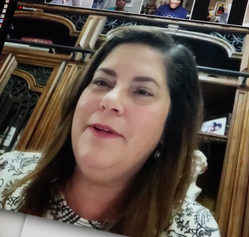 Aminda Marqués González (Mindy Marqués) (pictured), editor of The Miami Herald, announced in October that she was leaving the paper after 29 years to join Canedy at Simon & Schuster. The two got to know each other better when Canedy was administrator of the Pulitzer Prizes and Marques was on the Pulitzer board. “Mindy has selected — been in the board room — selecting a book for a Pulitzer Prize for almost a decade and all categories. All categories! — . . . people have won or lost Pulitzer Prizes because of what Mindy has said in that room,” Canedy told us.
Aminda Marqués González (Mindy Marqués) (pictured), editor of The Miami Herald, announced in October that she was leaving the paper after 29 years to join Canedy at Simon & Schuster. The two got to know each other better when Canedy was administrator of the Pulitzer Prizes and Marques was on the Pulitzer board. “Mindy has selected — been in the board room — selecting a book for a Pulitzer Prize for almost a decade and all categories. All categories! — . . . people have won or lost Pulitzer Prizes because of what Mindy has said in that room,” Canedy told us.
Canedy had other news: She was folding a Simon & Schuster imprint that focused on books featuring people of color. It was called 37 Ink, and it was headed by Dawn Davis, who left in August to become editor of Bon Appétit magazine.
“When she left, it made it easier for me to do this, because [having the imprint] just made it too easy for others to say, ‘That’s a 37 Ink book. Give it to her.’ I want to hold all of my editors accountable for publishing what would have been considered 37 Ink books, and I mean formally hold them accountable,” Canedy said. “They’re expected to do those books too. . . . We’re not going to lose our mandate and our commitment to what 37 Ink did, but now those books will say Simon & Schuster, and I think that reflects the importance of them to the core imprint.”
Canedy also let it be known that she is looking for another editor and would be delighted if it were a person of color.
Eighty-one people were on the Zoom call, which can be viewed on YouTube.
It was the largest number to participate in the 21 years of our Roundtables, excluding holiday parties and watchers on Facebook Live. Attendees left such comments as “That was the best Zoom session in forever” (Carolyn Lumsden, former opinion editor at the Hartford Courant); “This meeting is off the hook! Love the networking, and collaborations that are getting created. Shaking it up in 2021!” (veteran Cleveland journalist Margaret Bernstein); “This is the best session on book publishing I have ever attended” (Nichelle Smith of USA Today); “One of the most engaging zoom meetings ever,” (veteran D.C. journalist Ron Taylor); and “Such an illuminating conversation!” (Sheila Solomon, longtime Chicago journalist).
Bill Mitchell, CEO and publisher of the National Catholic Reporter who was formerly with the Poynter Institute, added, “Would be interesting in a few years to see how many first books were inspired by this session.”
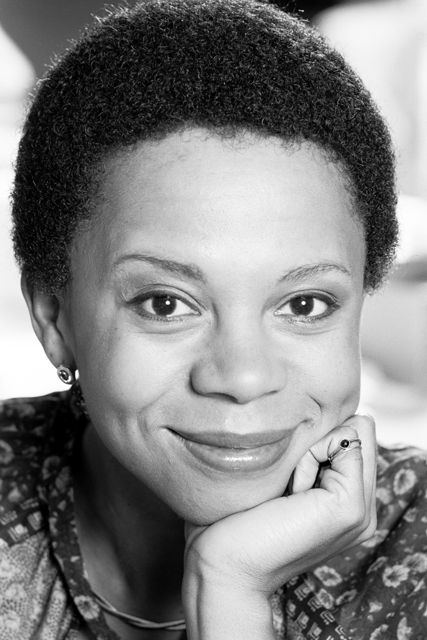 A surprise attendee was Melba Tolliver (pictured in 1977 at WNBC-TV, by Susan Wood), a retired New York news anchor who in 1971 made broadcast history when she decided to wear her hair naturally (audio), to her bosses’ disapproval. “I just wanted to be awed and inspired by this banquet of terrific speakers,” Tolliver said. “. . . And I’ve been writing a book, seems like forever. . . .”
A surprise attendee was Melba Tolliver (pictured in 1977 at WNBC-TV, by Susan Wood), a retired New York news anchor who in 1971 made broadcast history when she decided to wear her hair naturally (audio), to her bosses’ disapproval. “I just wanted to be awed and inspired by this banquet of terrific speakers,” Tolliver said. “. . . And I’ve been writing a book, seems like forever. . . .”
There were other revelations in a meeting that crammed much into a little over two hours.
We toasted Shirley Carswell, newly named director of the Dow Jones News Fund, which helps train high school and college journalists. “I’d like to focus on the lack of Black males. Black and brown males, actually, who come through the program,” she said. “In recent years, it seems like those numbers have dropped. And that’s not unusual because that’s the way journalism schools are, for the most part.”
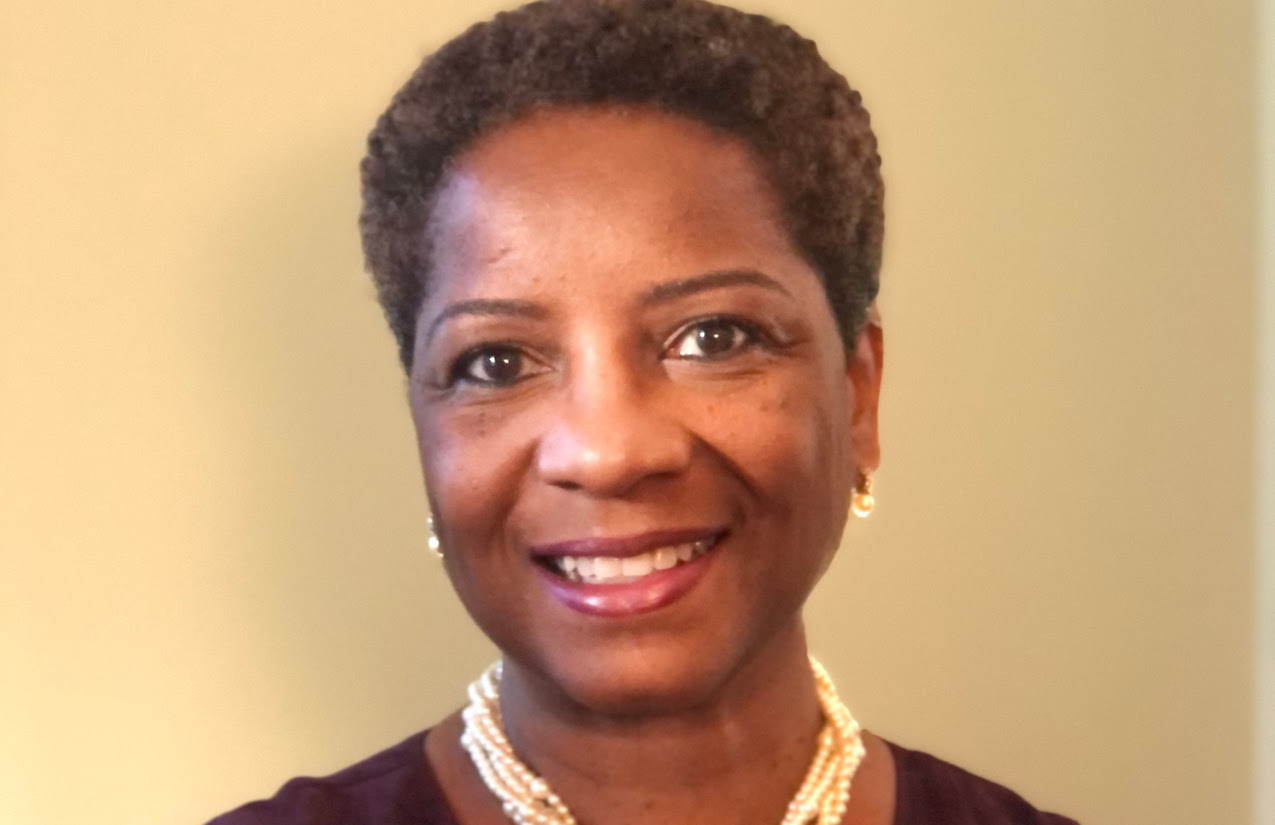 Carswell (pictured) also said she wanted to confront the challenge of the growing number of nonprofit news organizations, “because the way the program works is that we find the students, we vet the students, we train the students, and then we find news organizations to hire them for the summer. And so as the number of newsrooms has shrunk and the ability for them to pay for interns has shrunk, we also have that challenge of many more kinds of news organizations including nonprofits, but nonprofits don’t necessarily have the money to hire, so we’re trying to find more news organizations who want to hire our interns.”
Carswell (pictured) also said she wanted to confront the challenge of the growing number of nonprofit news organizations, “because the way the program works is that we find the students, we vet the students, we train the students, and then we find news organizations to hire them for the summer. And so as the number of newsrooms has shrunk and the ability for them to pay for interns has shrunk, we also have that challenge of many more kinds of news organizations including nonprofits, but nonprofits don’t necessarily have the money to hire, so we’re trying to find more news organizations who want to hire our interns.”
Karin Berry, general editor at The Undefeated, disclosed that an Undefeated book imprint is in the works. ESPN announced in March that it plans to “expand the outlet to other parts of the sports-media outlet’s parent company. Walt Disney,” as Brian Steinberg reported then for Variety.
The National Association of Black Journalists turned down a chance to hear from Canedy, then Pulitzer Prize administrator, at a session Canedy proposed on how to win a Pulitzer Prize. She was prepared to pay the $10,000 fee.
“How you apply, what we look for, what makes you competitive — and they declined. I couldn’t believe it,” Canedy said.
“And so, I would love to, as a publisher now, I’d love to do something with NABJ. I don’t know how receptive the leadership would be there, but if they would, I would absolutely do anything. Seminars on manuscripts — I could see us spending half a day on publishing. Because so many journalists, either to supplement their income or mostly because they have a big story to blow up after they break something for a while, do books. And we should be doing more of those. And also to do sessions on if you want to make the transition from journalism to publishing.”
NABJ President Dorothy Tucker told Journal-isms afterward that she would have to “do some checking” on what took place. “It sounds like a worthwhile session. I would certainly encourage Dana to submit the proposal again,” Tucker said.
Back to the book industry.
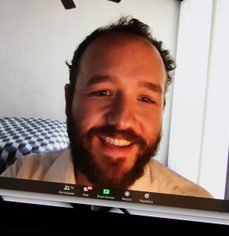 How many would have guessed that one of the chief impediments for journalists who write books is their own news organization?
How many would have guessed that one of the chief impediments for journalists who write books is their own news organization?
If the book idea is based on something they produced for their news outlet, their employers might want to keep the rights for themselves — so they can turn them into movies for Hollywood! So said Matt Pearce (pictured), a Los Angeles Times reporter who is president of MediaGuildWest and represented the News Guild on the panel.
“In the years before we were unionized, the company had been slowly broadening its policies so that it captured more of our creative work as journalists,” Pearce said. “It’s hard to write a book and also have a full-time job as a working journalist, so the ability to have a book leave can be a critical part in making that happen.
“We don’t have an entitlement to go off and write books. We didn’t win that in our contract. Would have been nice, we don’t have it, but that consideration should at least be equitable, management not playing favorites, especially if it’s not discriminatory, based on race, gender, other protected categories. That’s one of the really bedrock protections that our contract gives.”
Former and current Miami Herald journalists were curious about what Marqués plans. Her answer: “New voices that are part of the rich tapestry of this country but are not reflected broadly in what we’re seeing right now.
“Given my background, I’m really interested in immersive journalism, narrative nonfiction that marries deep reporting with exquisite narrative writing, and I’m also interested in books that might want to take a look back at a way to move forward and put into historical — to take historical events, add dimension, give us new revelatory details to help us move forward. I’m drawn to memoir and biography as well. I think [publishing] journalism books that really explore the diverse tapestry of this country is what I hope to have in my portfolio by the end of year one.”
Canedy said she wanted Marques to remain in Miami to bring a different perspective to the New York-centric industry.
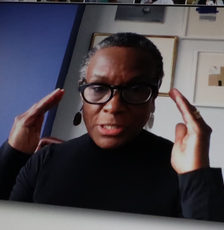 Literary agent Faith Childs (pictured), praised throughout the meeting as an icon in the industry, outlined why it was important for journalists of color to write in book form. “Let’s call it our cultural patrimony,” she said. “We all have horror stories from the business about, you know, Black books don’t sell, Black people don’t buy books — all of that is important for building up why these stories are important. You need your voices out there, that you can say what it was like in the newsrooms.
Literary agent Faith Childs (pictured), praised throughout the meeting as an icon in the industry, outlined why it was important for journalists of color to write in book form. “Let’s call it our cultural patrimony,” she said. “We all have horror stories from the business about, you know, Black books don’t sell, Black people don’t buy books — all of that is important for building up why these stories are important. You need your voices out there, that you can say what it was like in the newsrooms.
She cited Jill Nelson’s 1993 book “Volunteer Slavery: My Authentic Negro Experience,” about Nelson’s time at The Washington Post, a place where Simeon Booker was not able to go to the bathroom “when he got there yo so many years ago. Southern newsroom, Black man. . . . “
Booker, who died at 99 in 2017, became the Post’s first Black full-time reporter in 1952.
“But it’s those sorts of stories that we wouldn’t hear. . . .”
“Journalists are important contributors to our country’s literary life,” Pearce agreed. “One of our goals as a union is to help [produce environments that aid] journalists who are going to enrich the social life of our communities. He named “Enrique’s Journey: The Story of a Boy’s Dangerous Odyssey to Reunite With His Mother” by Sonia Nazario, “Ghettoside: A True Story of Murder in America” by Jill Leovy, “The Soloist: A Lost Dream, an Unlikely Friendship, and the Redemptive Power of Music” by Steve Lopez and “Dreamland: The True Tale of America’s Opiate Epidemic” by Sam Quinones as examples from L.A. Times writers.
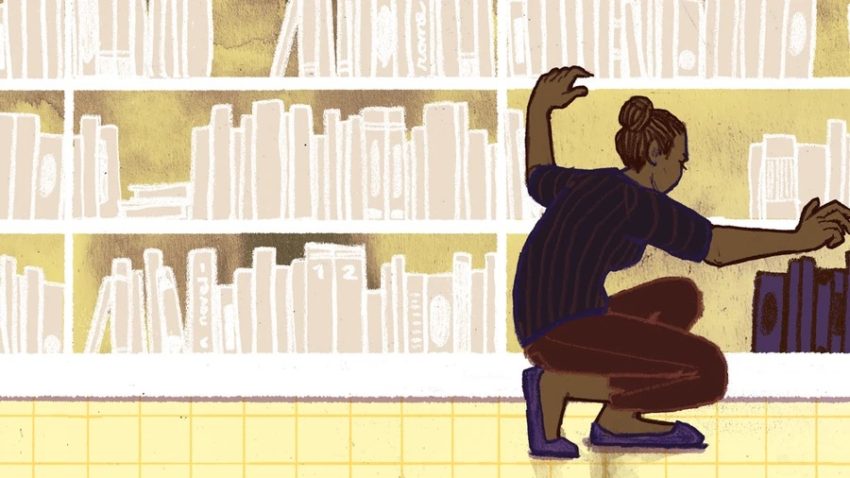
Calvin Reid, senior news editor at Publishers Weekly, has been covering the issue of race in the publishing industry for much of his 35 years at Publishers Weekly. In 1994 he wrote on the topic under the headline “Houses With No Doors.”
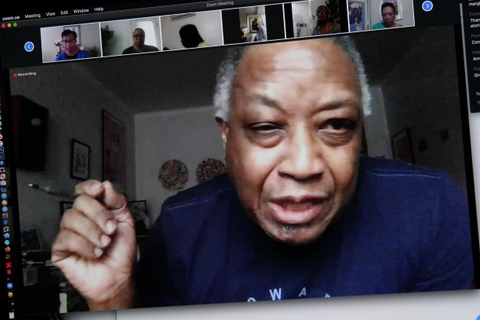 At the Roundtable, Reid (pictured) attributed the lack of people of color to “Exclusionary hiring practices over many, many decades. . . . not just at the editorial level, marketing, design, the warehouse level. There is a dramatic lack of nonwhite employees. There’s a certain cyclical outrage over it,” Reid said. But, he added, “We’re in a moment where maybe the words we’ve heard about publishing will actually become fact.” He cited a number of programs to address the issue, notably the Publishing Certificate Program at the City College of New York, founded in 1997 by novelist Walter Mosley.
At the Roundtable, Reid (pictured) attributed the lack of people of color to “Exclusionary hiring practices over many, many decades. . . . not just at the editorial level, marketing, design, the warehouse level. There is a dramatic lack of nonwhite employees. There’s a certain cyclical outrage over it,” Reid said. But, he added, “We’re in a moment where maybe the words we’ve heard about publishing will actually become fact.” He cited a number of programs to address the issue, notably the Publishing Certificate Program at the City College of New York, founded in 1997 by novelist Walter Mosley.
One of its five basic courses is a paid internship, emphasis on paid, which helps in “making the publishing industry pay attention to you if your degree isn’t Ivy League.”
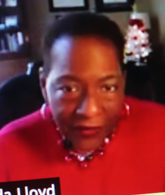 The book discussion started with the first-person experiences of former newspaper editor Wanda Lloyd, (pictured), author of “Coming Full Circle: From Jim Crow to Journalism” and co-editor with Tina McElroy Ansa of “Meeting at the Table: African-American Women Write on Race, Culture and Community.” Their conversation included Karen Gray Houston, broadcast journalist and author of “Daughter of the Boycott: Carrying on a Montgomery Family’s Civil Rights Legacy.”
The book discussion started with the first-person experiences of former newspaper editor Wanda Lloyd, (pictured), author of “Coming Full Circle: From Jim Crow to Journalism” and co-editor with Tina McElroy Ansa of “Meeting at the Table: African-American Women Write on Race, Culture and Community.” Their conversation included Karen Gray Houston, broadcast journalist and author of “Daughter of the Boycott: Carrying on a Montgomery Family’s Civil Rights Legacy.”
The attendees were part of the discussion, contributing tips about the need to market their books properly, how to secure a good agent, the importance of an effective presentation to agents and publishers, adapting one’s writing style to a book’s audience, the pros and cons of self-publishing and what publishers look for. The advice applied to fiction as well as nonfiction.
Boston radio journalist Kenneth Cooper, who watched later on YouTube, said he was glad to hear Canedy’s views on “comps,” a book industry term meaning that publishers look to see whether others have written on a similar theme. “To me, the best books are the ones that don’t have comps, that’s really new and different,” Canedy said. “And if the book is good, if the manuscript is well-thought out and well-written, it doesn’t really matter what it is. It’ll find a home.”
Said Cooper, “Book publishers have driven me crazy with that insistence on ‘comps’, which essentially penalizes originality.”
It wasn’t always what was said that impressed some viewers. The attendees were white, Black, Hispanic and Asian American (Native American invitees did not respond).
Mac Nwulu, a spokesman for ESPN, messaged, “Beyond being informative, it was inspiring for me – just seeing the collection of African American journalists and authors in the room.”
Likewise, the speakers were impressed. “I am so pleased to know that there is so much creative journalistic activity afoot,” Childs messaged.
Others were no doubt inspired by another bit of advice from Canedy.
“For anyone who has an idea that they believe in,” she said, “don’t give up on it.”
- Porter Anderson, publishingperspectives.com: US ‘Publishing Day of Action’ Calls Out Book Industry’s Racial Disparities (June 9)
- Crystal Chen, Woodstock Library, New York Public Library: Major Feelings: An Asian Pacific Islander Desi American (APIDA) Reading List (Nov. 20)
- Hillel Italie, Associated Press: Publishing Saw Upheaval in 2020, but ‘Books Are Resilient’ (Dec. 14)
- New York Public Library: Best Books for Adults 2020
- Haillie Parker and Allie Barton, Cronkite News: Invisible Chapters: Writing The Black Community Into The Stories Of Libraries, Bookstores And Publishing
- Raul A. Reyes, NBC News: 12 best Latino books of 2020: Books to read by Hispanic authors (Dec. 17)
- Emily Temple, lithub.com: The Ten Biggest Literary Stories of the Year
To subscribe at no cost, please send an email to journal-isms+subscribe@groups.io and say who you are.
Facebook users: “Like” “Richard Prince’s Journal-isms” on Facebook.
Follow Richard Prince on Twitter @princeeditor
Richard Prince’s Journal-isms originates from Washington. It began in print before most of us knew what the internet was, and it would like to be referred to as a “column.” Any views expressed in the column are those of the person or organization quoted and not those of any other entity. Send tips, comments and concerns to Richard Prince at journal-isms+owner@
View previous columns (after Feb. 13, 2016).
View previous columns (before Feb. 13, 2016)
- Diversity’s Greatest Hits, 2018 (Jan. 4, 2019)
- Book Notes: Is Taking a Knee Really All That? (Dec. 20, 2018)
- Book Notes: Challenging ’45’ and Proudly Telling the Story (Dec. 18, 2018)
- Book Notes: Get Down With the Legends! (Dec. 11, 2018)
- Journalist Richard Prince w/Joe Madison (Sirius XM, April 18, 2018) (podcast)
- Richard Prince (journalist) (Wikipedia entry)
- February 2018 Podcast: Richard “Dick” Prince on the need for newsroom diversity (Gabriel Greschler, Student Press Law Center, Feb. 26, 2018)
- Diversity’s Greatest Hits, 2017 — Where Will They Take Us in the Year Ahead?
- Book Notes: Best Sellers, Uncovered Treasures, Overlooked History (Dec. 19, 2017)
- An advocate for diversity in the media is still pressing for representation, (Courtland Milloy, Washington Post, Nov. 28, 2017)
- Morgan Global Journalism Review: Journal-isms Journeys On (Aug. 31, 2017)
- Diversity’s Greatest Hits, 2016
- Book Notes: 16 Writers Dish About ‘Chelle,’ the First Lady
- Book Notes: From Coretta to Barack, and in Search of the Godfather
- Journal-isms’ Richard Prince Wants Your Ideas (FishbowlDC, Feb. 26, 2016)
- “JOURNAL-ISMS” IS LATEST TO BEAR BRUNT OF INDUSTRY’S ECONOMIC WOES (Feb. 19, 2016)
- Richard Prince with Charlayne Hunter-Gault,“PBS NewsHour,” “What stagnant diversity means for America’s newsrooms” (Dec. 15, 2015)
- Book Notes: Journalists Follow Their Passions
- Book Notes: Journalists Who Rocked Their World
- Book Notes: Hands Up! Read This!
- Book Notes: New Cosby Bio Looks Like a Best-Seller
- Journo-diversity advocate turns attention to Ezra Klein project (Erik Wemple, Washington Post, March 5, 2014)

